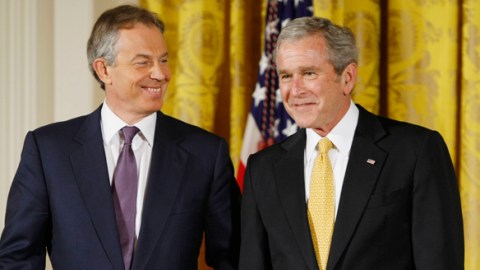The Iraq War in Hindsight: How Journalism Is Versus How It Should Be

–Guest post by Sarah Merritt, American University doctoral student.
As we begin to look back at the Iraq war in hindsight, it is clear that more scholarship needs to focus on how both small and large-scale journalistic systems operate in times where going to war should be deemed controversial and the subject of public skepticism.
As the University of Pennsylvania’s Barbie Zelizer explains, much of the relevant scholarship in political science involves inquiring how journalism is versus how it ought to be, including the interaction between the journalist and the source as well as the functioning of journalism’s intersection with the political world. In the case of the Iraq war, both of these factors played a role.
Bill Moyer’s 2007 documentary “Selling the War” about the press’s involvement with the government in pushing for the war in Iraq identified several conditions and factors that constrained the independence and skepticism of journalists and their news organizations. As Moyers opens the film:
The story of how high officials misled the country has been told. But they couldn’t have done it on their own; they needed a compliant press, to pass on their propaganda as news and cheer them on. Since then thousands of people have died, and many are dying to this day.
According to the documentary, patriotic fervor made journalists less willing to ask difficult questions or even question the facts set forth by the Bush administration. Journalists’ own emotions, especially those who covered Ground Zero, potentially interfered with challenging the President’s claims and decisions. News organizations – notably CNN — even felt threatened to post pictures of civilian war casualties with a CNN memo warning that advertisers and audiences might be lost if coverage was too critical of the Administration.
With regard to small-scale journalistic practices, sourcing practices as described by Zelizer and identified in the Moyers film as specific to the coverage of claims of weapons of mass destruction enabled the government to make the case to go to war. Scholar Michael Schudson warns about the social organization of newswork that “the reality-constructing practices of the powerful will fail (in the long run) if they ride roughshod over the world “out there.”
As social scientists, we view political news making as reality-constructing, too often following the lead of government officials and others in power. Sourcing practices define journalism on a day-to-day basis, where the interaction of reporters and government officials is central. As in the case with the decision to go to war in Iraq, analysts agree, according to Schudson, that officials have the ‘upper hand.’
As Sigal (1986) asserted, “News is not what happens, but what someone says has happened or will happen” (p.25). All too true in the case of weapons of mass destruction.
If you haven’t watch the Billy Moyers’ documentary Selling the War, the full film is available online. Below is a trailer.
–Guest post by Sarah Merritt, a doctoral student at American University’s School of Communication. Read other posts by AU doctoral students and find out more about thedoctoral program in Communication at American University.
REFERENCES
Moyer, B. (2007). Buying the war: How did the mainstream press get it so wrong? Bill Moyer’s Journal. Retrieved online from http://www.pbs.org/moyers/journal/btw/watch.html.
Schudson, M. (2002). The news media as political institutions. Annual Review of Political Science, 5(1), 249-269.
Sigal, L. (1986). Sources make the news. In R. Manoff & M. Schudson (Eds.), Reading the News (pp.9-37). New York: Pantheon.
Zelizer, B. (2004). Chapter 6: Sociology and Journalism. Taking journalism seriously: News and the academy (pp.145-173). Sage Publications, Inc.





